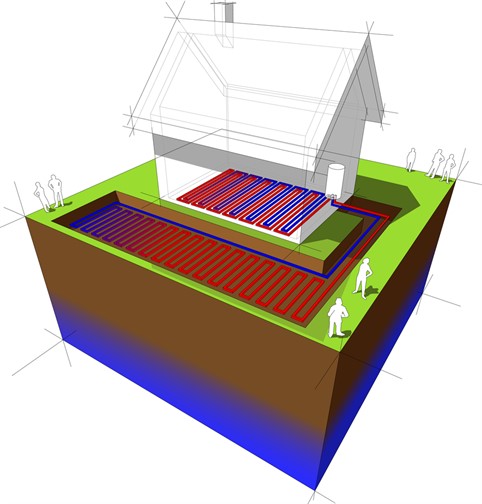Answer these simple questions and we will find you the BEST prices
Which type of solar quotes do you need?
It only takes 30 seconds
100% free with no obligation

You need to fill in only 1 form to get free quotes

We call you to confirm your enquiry

Receive quotes from local installers
- GreenMatch
- Blog
- What Is Geothermal HVAC?
What Is Geothermal HVAC?
Information About Geothermal HVAC
Geothermal HVAC refers to geothermal heating, cooling and ventilation. Geothermal HVAC uses energy stored in the ground to heat and cool your home. That way, heating, ventilation and air conditioning benefit from the free and renewable geothermal energy.
Geothermal HVAC is part of the geothermal heating system along with:
How Does the Geothermal Heating System Work?
The surface of the Earth is a natural heat accumulator. This heat is stored below the frost line and can be extracted by using a pipe loop system and a heat pump. The loops are laid horizontally or vertically, with the purpose of absorbing the heat from the ground. Through the loops, a mixture of water and antifreeze circulates.

The loops carry the heated liquid to your home, where the heat pump is located (usually in the basement). The heat pump extracts the heat from the liquid and pushes it to your HVAC system, which then distributes it throughout the house. After the heat is removed, the water circulates back into the loop system and the process is repeated.
Can You Use Your Current HVAC With Geothermal Energy?
Yes, you can. However, your current HVAC system needs to be suited to the new source of energy. A ground source heat pump will extract the free heat from the ground and transfer it to your home. From there, your HVAC will distribute the heating throughout the space.
Your current HVAC system needs to be fitted with the ground source heat pump in order to deliver all that free heat and cooling. By filling your information on our contact form, you will receive up to four free-tailored quotes from our specialist suppliers.
Discover Geothermal Cooling
Although geothermal energy is mostly associated with heating, you should not overlook the potential of cooling. In the cooling mode, heat is extracted from the air in your home and replaced with cool air from the ground. This is possible because the Earth has a constant temperature year-round and can act as a heat sink in the summer. You do not have to worry anymore about your AC system failing and reduce the need for mechanical HVAC.
What About Geothermal Ventilation?
At the core of the geothermal system is the continuous temperature exchange with the Earth.
Through this process, the air in your home is constantly replaced. In the spring and fall months, when the temperatures between your house and outdoor are insignificant, the air can be supplied through the intake grill.
Where Is Geothermal HVAC Currently Used?
Geothermal HVAC can be implemented in large commercial buildings as well as in small residential homes. The only difference is the size of the ground loops that need to be buried in the ground. In Norway, for example, Nydalen Business Park benefits from geothermal heating and cooling. Also, Akershus University Hospital produces 8 MW of cooling and 28 MW of heating. The country’s national stadium and airport also employ geothermal HVAC. The airport investment is estimated to pay itself in less than 2 years.
In the US, over one million ground source heat pumps have been installed in both residential and commercial settings. Yet, few people know how it works and the cost savings it can bring to your home.
Why Should You Switch to Geothermal Energy?
Geothermal power is free, renewable and sustainable. Geothermal energy can provide your household with heating and cooling methods, hot water supply, and air conditioning. The source is free and renewable. The heat from the sun is stored in the upper layer of the ground, and this makes geothermal energy a reliable source that will provide you with constant heating and cooling.
If that hasn’t convinced you yet, I have more good news for you: government incentives. The current Renewable Heat Incentive (RHI) pays for the heat and hot water you generate. The tariff pays for 20 years from the registration date. The rate paid depends on what system you have in place. So start today by getting your free quote here.
Fill in the form in just 1 minute
We strive to connect our customers with the right product and supplier. Would you like to be part of GreenMatch?




